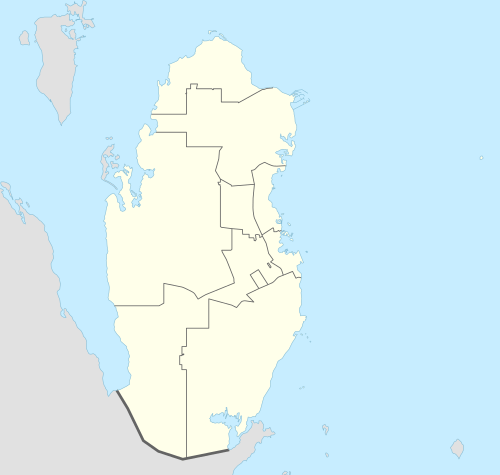Mushayrib
| Mushayrib | |
|---|---|
| Settlement | |
.jpg) | |
 Mushayrib | |
| Coordinates: 25°17′N 51°31′E / 25.283°N 51.517°ECoordinates: 25°17′N 51°31′E / 25.283°N 51.517°E | |
| Country | Qatar |
| Municipality | Doha |
| Area | |
| • Total | 1.0 km2 (0.4 sq mi) |
| Population | |
| • Total | 22,711 |
| • Density | 23,000/km2 (59,000/sq mi) |
.jpg)
Mushayrib, also spelled Musheireb, is a settlement in Qatar, located in the municipality of Ad Dawhah.[1] As of the 2010 census, the former district of Al Asmakh has been integrated into Mushayrib.[2][3]
History
In J. G. Lorimer's Gazetteer of the Persian Gulf published in 1904, Mushayrib was described as a place where the town of Al Bidda obtained its water supply from, but described the water as brackish and scanty.[4]
The majority of Mushayrib's residents are expat workers. In 2014, the government forcibly evicted several hundred residents from the neighborhood in preparation for the development of several new up-scale buildings and the demolition of older buildings.[5]
Localities
Al Asmakh
Formerly a stand-alone district, Al Asmakh has been amalgamated into Mushayrib since the 21st century.[2][3] Al Asmakh was initially recognized as a formal district of Doha around the 1930s. Located near Souq Waqif, it covers an area of about 326,000 sq m². Although most of its historic architecture has been degraded or demolished, there remains some standing buildings which date back to the early 20th century. Currently, it is populated mainly by migrant workers. Residential housing in the area is tightly packed and the streets are relatively narrow.[6]
Demographics
As of the 2010 census, the settlement comprised 6,745 housing units[7] and 1,009 establishments.[8] There were 22,711 people living in the settlement, of which 83% were male and 17% were female. Out of the 22,711 inhabitants, 88% were 20 years of age or older and 12% were under the age of 20.[9]
Employed persons made up 79% of the total population. Females accounted for 4% of the working population, while males accounted for 96% of the working population.[9]
| Year | Population |
|---|---|
| 1986[10] | 7,333 |
| 1997[11] | 7,914 |
| 2004[2] | 9,655 |
| 2010[1] | 22,711 |
References
- 1 2 "2010 population census" (PDF). Qatar Statistics Authority. Retrieved 29 June 2015.
- 1 2 3 "2004 population census". Qatar Statistics Authority. Retrieved 1 July 2015.
- 1 2 Chantelle D'Mello (5 July 2014). "Three days later, Musheireb residents still struggling after eviction". Doha News. Retrieved 7 August 2015.
- ↑ "'Persian Gulf Gazetteer Part II, Geographical and Descriptive Materials, Section II Western Side of the Gulf' [55v] (113/286)". Qatar Digital Library. Retrieved 23 July 2015.
- ↑ Chantelle D'Mello (2 July 2014). "Hundreds of low-income expats in Qatar left homeless after eviction". Doha News. Retrieved 15 August 2015.
- ↑ Djamel Boussaa (May 2014). "Al Asmakh historic district in Doha, Qatar: From an urban slum to living heritage". Journal of Architectural Conservation. 20 (1): 2–15. doi:10.1080/13556207.2014.888815. Retrieved 26 December 2015.
- ↑ "Housing units, by type of unit and zone (April 2010)" (PDF). Qatar Statistics Authority. Retrieved 7 August 2015.
- ↑ "Establishments by status of establishment and zone (April 2010)" (PDF). Qatar Statistics Authority. Retrieved 7 August 2015.
- 1 2 "Geo Statistics Application". Ministry of Development Planning and Statistics. Retrieved 7 August 2015.
- ↑ "1986 population census" (PDF). Qatar Statistics Authority. Retrieved 2 July 2015.
- ↑ "1997 population census" (PDF). Qatar Statistics Authority. Retrieved 2 July 2015.